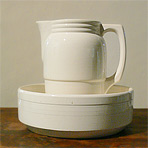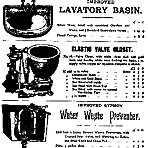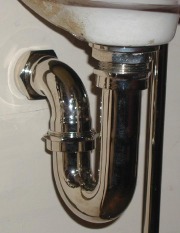NINE REASONS NOT TO
RESTORE YOUR BATHROOM
More background information
- Video
- Video of cast iron bath manufacturing
- Video of lost wax casting
- Video of chinaware manufacturing
- Bathroom design
- Victorian bathroom design
- Create an art deco bathroom suite
- How to restore your bathroom
- Nine Reasons not to restore your bathroom
- Door furniture
- The secrets behind buying traditional door knobs
- The lost wax process
- Bathroom techniques
- Bath casting
- Bath enamelling
- Bath finishing
- External links
Bathroom history makes an authentic period bathroom
look like a pipe dream
The idea sounds good: a charming antique bathroom that matches the august age of your home. The reality is a little more tricky, not to mention downright yucky in some areas. What were old bathrooms really like?
If your house is really old…
 It probably didn’t have a bathroom. The Romans had them, but then the art of distributing water to homes was lost until early Victorian times. For the few who did bathe, a portable bath filled by hand in front of the fire or a quick wash from a jug and pitcher or even outside at the pump sufficed.
It probably didn’t have a bathroom. The Romans had them, but then the art of distributing water to homes was lost until early Victorian times. For the few who did bathe, a portable bath filled by hand in front of the fire or a quick wash from a jug and pitcher or even outside at the pump sufficed.
Most people didn't wash though. At the turn of the nineteenth century, the Duke of Wellington was considered eccentric for bathing once a week. The Church for many years considered washing a sign of vanity, so there was even religous justification for being dirty!
As for WCs, flushing toilets didn't come into general use in the UK until the 1830s, and even then, they they were only to be found in better-class houses. Less well off people used chamber pots, primitive earth closets – a seat above a hole in the ground inside or outside the house – or, in the towns, unhygenic privies set over a cesspool in the back yard. Not something most modern homeowners would want.
There is lots of interesting information on the web about sanitation history. Some useful resources are:
- The development of toilets
- The history of Plumbing
- A Glimpse Into London's Early Sewers
- Dictionary of Victorian London
Toilet in the hall? Lounge? Pick your spot
Really rich people were the only ones to have a toilet in the very early days. And without a bathroom, WCs went anywhere, often dressed up to look like a bench or other furniture. Even diehard bathroom restorationists tend to draw the line here.
Chunky basins
 Do you like chunky basins? In the nineteenth century, bathroom items were made of earthenware, not of china like now. And earthenware is much harder to mould, so basins and pans were more rounded and solid than our modern versions. They were also off-white and glazed. All of which looks old-fashioned and just plain wrong to twenty-first century eyes accustomed to fine lines, smooth curves and bright white from their bathroom chinaware.
Do you like chunky basins? In the nineteenth century, bathroom items were made of earthenware, not of china like now. And earthenware is much harder to mould, so basins and pans were more rounded and solid than our modern versions. They were also off-white and glazed. All of which looks old-fashioned and just plain wrong to twenty-first century eyes accustomed to fine lines, smooth curves and bright white from their bathroom chinaware.
Tarnished fittings anyone?
Brass was the only metal available for fittings in Victorian times. And it wasn’t lacquered so old bathroom fittings tarnished badly. Many customers do like the look of Drummonds’ brass taps. But our chrome or nickel finished fittings have more modern appeal. And even brass lovers wouldn’t want tarnished plug holes.
How about spoutless taps?
Early Victorians had tap heads but no spouts for the water to come out of. Instead, water poured out of holes in the basin. Much messier than our current practice.
Removable toilet seats
 Toilet seats weren’t attached in the nineteenth century. They hung just on top of the pan from a bar supported by brackets from the floor. Strange, yes, but this antique custom might actually have advantages. It would make thorough cleaning of a notoriously dirty item of furniture a little bit easier.
Toilet seats weren’t attached in the nineteenth century. They hung just on top of the pan from a bar supported by brackets from the floor. Strange, yes, but this antique custom might actually have advantages. It would make thorough cleaning of a notoriously dirty item of furniture a little bit easier.
Roof tanks
The Victorians started building reservoirs and began piping water to homes. But progress was slow so most Victorian bathrooms were fed from roof tanks filled from a well. The resulting pressure is much lower than what we get from the mains.
As a result, most Victorian, Edwardian and even earlier twentieth century taps simply can’t cope with our high pressure systems. If you want to use unadapted old taps, you would need either pressure reducing valves or a Victorian-style open tank system as well.
Big pipes for showers
Showers weren’t introduced until the 1860s-70s. And even then, they worked differently. Like taps, showers expected lower pressure than we get from the mains. Big heavy pipe work was then necessary to supply enough water for a good dousing.
To use a quaint old shower today, you need either:
- An open tank system with big pipes
- A pump that supplies water at lower pressure
Break the toilet law
 Modern British water regulations require a 5" depth of water in the trap of toilets and basins (the trap is the water-filled U-shaped pipe at the back) to prevent smells and poisonous gases seeping up from the sewers. Many Victorian loos and basins only had 1˝" depth of water in the trap. Flush something really big (!) down the loo and that depth of water could disappear allowing all those noxious vapours to emerge.
Modern British water regulations require a 5" depth of water in the trap of toilets and basins (the trap is the water-filled U-shaped pipe at the back) to prevent smells and poisonous gases seeping up from the sewers. Many Victorian loos and basins only had 1˝" depth of water in the trap. Flush something really big (!) down the loo and that depth of water could disappear allowing all those noxious vapours to emerge.
Where there's a will, there's a way
All this may sound a bit negative. If you are enthusiastic about recreating a genuinely old looking bathroom, there are ways round the problems. Read How to restore your bathroom for practical advice.
Author: James Walker, Drummonds
Site links:

